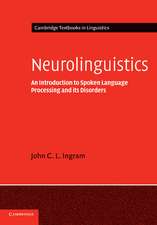Progression and Regression in Language: Sociocultural, Neuropsychological and Linguistic Perspectives
Editat de Kenneth Hyltenstam, Ake Vibergen Limba Engleză Paperback – 26 ian 1994
Preț: 365.19 lei
Nou
Puncte Express: 548
Preț estimativ în valută:
69.88€ • 73.48$ • 57.74£
69.88€ • 73.48$ • 57.74£
Carte tipărită la comandă
Livrare economică 17 aprilie-01 mai
Preluare comenzi: 021 569.72.76
Specificații
ISBN-13: 9780521438742
ISBN-10: 0521438748
Pagini: 502
Ilustrații: index
Dimensiuni: 152 x 229 x 26 mm
Greutate: 0.8 kg
Ediția:New.
Editura: Cambridge University Press
Colecția Cambridge University Press
Locul publicării:Cambridge, United Kingdom
ISBN-10: 0521438748
Pagini: 502
Ilustrații: index
Dimensiuni: 152 x 229 x 26 mm
Greutate: 0.8 kg
Ediția:New.
Editura: Cambridge University Press
Colecția Cambridge University Press
Locul publicării:Cambridge, United Kingdom
Cuprins
Part I. Introduction: 1. Linguistic progression and regression: an introduction Kenneth Hyltenstam and Åke Viberg; Part II. The Sociological Setting: 2. The role of pidgin and creole languages in languages progression and regression Peter Mühlhaüsler; 3. Structure and practice in language shift Jane Hill; 4. Growing up monolingual in a multilingual community: how language socialisation patterns are leading to language shift in Gapun (Papua New Guinea) Don Kulick; 5. Language change in a creole continuum: decreolisation? Charlene Sato; Part III. Psycho- and Neurolinguistic Aspects: 6. Neurolinguistic aspects of first language acquisition and loss Jean Berko Gleason; 7. Neurolinguistic aspects of second language development and attrition Loraine K. Obler; 8. Second language acquisition as a function of age: research findings and methodological issues; 9. Second language regression Alzheimer's dementia Kenneth Hyltenstam and Christopher Stroud; Part IV. The Linguistic Perspective: 10. Crosslinguistic perspectives on native language acquisition Ruth Berman; 11. Syntactic development in Danish L2 Anne Holmen; 12. The weaker language in bilingual Swedish–French children Suzzane Schlyter; 13. Four operating principles and input distribution as explanations for underdeveloped and mature morphological systems Roger Andersen; 14. Crosslinguistic perspectives on lexical organisation and lexical progression Åke Viberg; 15. Attrition or expansion? changes in the lexicon of Finnish and American adult bilinguals in Sweden Sally Boyd; Part V. The Linguistic Perspective 2: Phonology: 16. The development of phonological abilities Henning Wode; 17. The course of development in second language phonology acquisition: a natural path or strategic choice? Bjorn Hammarberg; 18. Sociolinguistic factors in loss and acquisition of phonology Roy C. Major; Index.
Descriere
Crosslinguistic studies of language progression and regression in societies and individuals, first published in 1994.

















